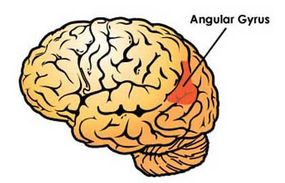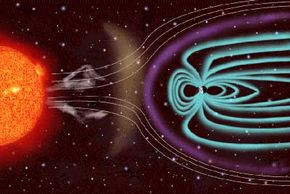Ghosts and Electrical Fields
In some haunted locations, researchers have measured magnetic fields that are stronger than normal or which exhibit unusual fluctuations. These may be localized phenomena that stem from electronic equipment or geological formations, or they may be part of the Earth's magnetic field.
Some paranormal investigators think of this as proof of a supernatural presence -- the ghosts create the field. Others suggest that these fields can interact with the human brain, causing hallucinations, dizziness or other neurological symptoms. Some researchers have theorized that this is one of the reasons people report more ghostly activity at night. Because of the way the solar wind interacts with the Earth's magnetosphere, the planet's magnetic field stretches out on the side that's in darkness. Some researchers hypothesize that this expanded field interacts more strongly with people's brains.
Advertisement
Medical researchers have also studied the effects of electrical fields on people's brains. Electrical stimulation to the angular gyrus of the brain, for example, can cause the sensation of someone behind you mimicking your movements. Electrical stimulation to different parts of the brain has also caused people to hallucinate or seem to have near-death experiences.

Temperature
Cold spots are a common phenomenon in buildings that are thought to be haunted. People describe sudden drops in temperature or localized cold areas in an otherwise warm room. Often, researchers can trace the cold spot to a specific source, like a drafty window or a chimney. The sensation of a lower temperature can also come from reduced humidity. In Wiseman's study at Mary King's Close, the locations reported to be haunted were significantly less humid than those that were not.
Low-frequency Sound Waves
Several experiments have demonstrated that low-frequency sound waves, known as infrasound, can cause phenomena that people typically associate with ghosts. This includes feelings of nervousness and discomfort as well as a sense of a presence in the room. The sound waves may also vibrate the human eye, causing people to see things that are not there. Usually, these waves have frequencies of less than 20 Hz, so they are too low-pitched for people to actually perceive. Rather than noticing the sound itself, people notice its effects.
Sometimes, researchers can locate the source of the sound. The article "The Ghost in the Machine" by Vic Tandy and Tony Lawrence describes a low-frequency standing wave originating from a fan. The sound wave disappeared after the researchers modified the fan's housing. When the wave dissipated, so did the symptoms of haunting in the building. You can learn more about infrasound at the Infrasonic site.
The most skeptical researchers believe that all ghostly phenomena have rational explanations. Those who try to prove the existence of ghosts, however, claim that while some events have rational explanations, others can only be supernatural in origin. Regardless of whether ghosts are real, many people find them fascinating. This fascination has a number of likely causes, from curiosity about what happens to people after death to the comforting idea that deceased loved ones are still nearby. Ghost stories, like urban legends, can also express people's fears about the unknown and caution people about the consequences of actions.
On the other hand, in its Science and Engineering Indicators report, the National Science Board (NSB) asserts that belief in the paranormal can be dangerous. According to the NSB, belief in the paranormal is a sign of reduced critical thinking skills and a reduced ability to make day-to-day decisions. However, since it's virtually impossible to prove that something does not exist, people will probably continue to believe in ghosts and haunted houses, especially since unexplained events aren't likely to go away anytime soon.
Keep reading for more information on ghosts, urban legends and related topics.
Related Articles
More Great Links
Sources
- Burks, Eddie and Gillan Cribbs. "Ghosthunter: Investigating the World of Ghosts and Spirits." Headline Book Publishing. 1995.
- Frood, Arran. "Ghosts 'All in the Mind.'" BBC News, May 21, 2003. http://news.bbc.co.uk/2/hi/science/nature/3044607.stm
- Ghost Research Foundation http://www.ghostsrus.com/
- Hainning, Peter. "Ghosts: The Illustrated History." Chartwell Books. 1974.
- Handwerk, Brian. "Creepy 'Shadow Person' Effect Conjured by Brain Shocks." National Geographic News. September 20, 2006. http://news.nationalgeographic.com/news/2006/09/060920-shadow-person.html
- Lyons, Linda. "One-third of Americans Believe Dearly May Not Have Departed." The Gallup Poll News Service, July 12, 2005.
- McCue, Peter A. "Theories of Haunting: A Critical Overview." Journal of the Society for Psychical Research. January 2002.
- Nickel, Joe. "In Search of Fischer's Ghost." Skeptical Inquirer Magazine, May/June 2001. http://www.csicop.org/si/2001-05/i-files.html
- Nickell, Joe. "Ghostly Photos." Skeptical Inquirer Magazine, July/August 1997. http://www.csicop.org/si/9607/ghost.html
- Nickell, Joe. "Haunted Inns: Tales of Spectral Guests." Skeptical Inquirer Magazine, September/October 2000. http://www.csicop.org/si/2000-09/i-files.html
- Radford, Benjamin. "The Voice of Reason: Giving Up the Ghosts." LiveScience, December 10, 2004. http://www.livescience.com/othernews/reason_exorcism_041210.html
- Roberts, Nancy. "Ghosts from the Coast." University of North Carolina Press, 2001.
- Rothschild, Bertram. "The Ghost in My House: An Exercise in Self-Deception." Skeptical Inquirer Magazine, January/February 2000. http://www.csicop.org/si/2000-01/ghost.html
- Shermer, Michael. "Demon-Haunted Brain." Scientific American, March 2003. http://www.sciam.com/article.cfm?articleID=00079AC8-53A5-1E40-89E0809EC588EEDF&sc=I100322
- Tandy, Vic. "Something in the Cellar." Journal of the Society for Psychical Research. Vol 74.3, No. 860.
- Tandy, Vic. "The Ghost in the Machine." Journal of the Society for Psychical Research. Vol. 62, No. 851.
- "Mysteries of the Unknown: Phantom Encounters." Time-Life Books, 1988.
- "Scientist Spooked by Ghost Study." BBC, May 19, 2005. http://news.bbc.co.uk/2/hi/uk_news/scotland/4564383.stm
- Wiseman, Richard, et. Al. "An Investigation into Alleged 'Hauntings.'" British Journal of Psychology, 2003.
